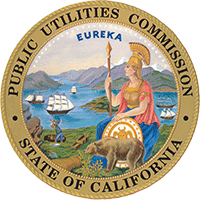Energization Customer Engagement and Communication Plans
To meet the requirements established in AB 50 and SB 410 that aim to accelerate the energization process, D.24-09-020 directed the utilities to provide customers seeking new or upgraded service with education and materials to improve the customer’s understanding of the energization process. This includes outlining the steps of the energization process, the party responsible for completing each step, the anticipated time needed to complete each step, common reasons for why energization delays occur, and efforts the customer and utility can take to avoid and/or resolve energization delays.
Decision 24-09-020 directed the utilities to take a number of steps to improve customer understanding of the energization process and to provide them with transparency of the status of their energization request, including:
- Within 10 business days of the application for service being approved by the utility, assign the customer with a dedicated account/project manage that will serve as the main point of contact throughout the life of the energization process for all customer questions, provide periodic updates on the project status, and address customer concerns. The account/project manage must provide the customer the option for reoccurring meetings, both the frequency and duration determined by the customer, to provide the following information:
- An overview of the energization process, including the steps to complete a request, the party responsible for completing each step, the adopted average and maximum energization targets, and the efforts a customer can take to avoid energization delays
- Monthly project status updates that: 1) identify the current energization step the project is in, 2) the total number of business and calendar days the project has been open, broken into the number of days that are within the utility’s control and customer’s control, and 3) define the status of the utility’s efforts to complete the pending work, and the anticipated completion date.
- No less than 72 hour notice prior to the scheduled task of the utility needed to reschedule or cancel work, and the reasons why the utility must reschedule or cancel. Any delays task must be rescheduled within 20 business days.
- Within 48 hours of knowing a delay is occurring, or expected to occur, the account/project manager must discuss with the customer the cause of the delay, who is responsible for resolving the delay, and estimate timeframe for when the delay will be resolved, and potential options to remedy the delay.
- Within 10 business days of identifying reasons that could cancel or delay a customer’s energization request, the utility shall provide the customer with clear steps necessary to ensure their project can continue uninterrupted.
- Provide the customer with notice within 5 business days of a reassignment of the dedicated account/project manager. The new account/project manage must be provided with full information on the details and status of each project at the time of their assignment to the customer.
The decision also directs the utilities to submit a Customer Engagement and Communication Plan to the Commission. These Customer Engagement and Communication Plans must describe what existing customer communication systems can be utilized to provide customers with energization requests with more detailed information about the energization process and the timing of their requests. These plans should not only be used to improve customer outreach but also be used by the utilities to inform their recruiting, training, and retaining programs for employees needed to promptly respond to customer energization requests. The utilities’ plans include the following information:
- An explanation for how the utility will explain the scope of each step of the energization process, including, 1) the party responsible for completing each step, 2) the documentation the utility needs from the customer to demonstrate a step within the customer’s control is completed, 3) how the utility will communicate to the customer when a utility-led step is completed, and 4) how the utility will communicate the identification of an energization delay(s), and the process to resolve the delay (if the delay falls under the utility’s responsibility.
- An explanation for how the adopted average and maximum energization targets apply to each project, including, 1) how the utility will communicate the expected timing to complete each step, 2) an outline of the different timing needs that are inherently built into the efforts to complete an energization request, 3) how the site/project characteristics (i.e., geography, local permitting requirements, lack of known upstream capacity availability, etc.) may impact the timing needed to complete the energization request, 4) how the utility will timely and clearly communicate an expected delay(s) to the customer, and how they will address the delay(s), 5) when a utility-responsible delay occurs, information about how long the delay will take to remedy.
- If opting to develop an online web portal, an explanation of, 1) the process(es) to develop the web portal, 2) information that will be presented to the customer and how it will be presented, 3) how long it will take for the utility to build the web portal, and 4) the total expected costs to develop, operate, and maintain the web portal.
